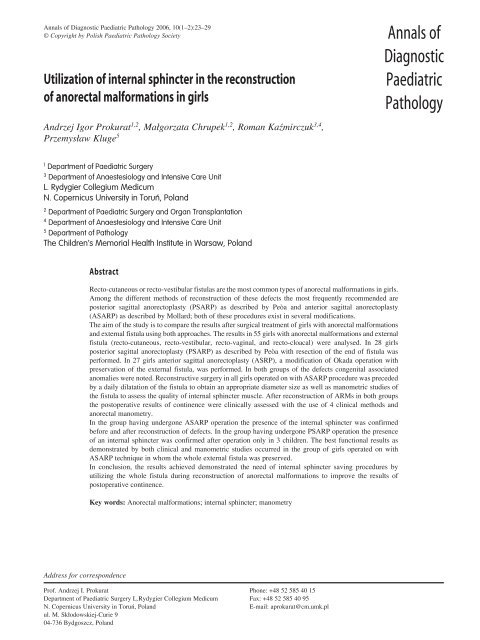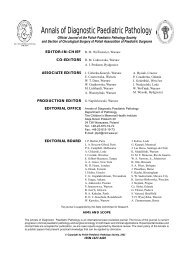annals 1-2.qxd - Centrum Zdrowia Dziecka
annals 1-2.qxd - Centrum Zdrowia Dziecka
annals 1-2.qxd - Centrum Zdrowia Dziecka
Create successful ePaper yourself
Turn your PDF publications into a flip-book with our unique Google optimized e-Paper software.
Annals of Diagnostic Paediatric Pathology 2006, 10(1–2):23–29<br />
© Copyright by Polish Paediatric Pathology Society Annals of<br />
Utilization of internal sphincter in the reconstruction<br />
of anorectal malformations in girls<br />
Andrzej Igor Prokurat 1,2 , Ma³gorzata Chrupek 1,2 , Roman KaŸmirczuk 3,4 ,<br />
Przemys³aw Kluge 5<br />
Diagnostic<br />
Paediatric<br />
Pathology<br />
1<br />
Department of Paediatric Surgery<br />
3<br />
Department of Anaestesiology and Intensive Care Unit<br />
L. Rydygier Collegium Medicum<br />
N. Copernicus University in Toruń, Poland<br />
2<br />
Department of Paediatric Surgery and Organ Transplantation<br />
4<br />
Department of Anaestesiology and Intensive Care Unit<br />
5<br />
Department of Pathology<br />
The Children's Memorial Health Institute in Warsaw, Poland<br />
Abstract<br />
Recto-cutaneous or recto-vestibular fistulas are the most common types of anorectal malformations in girls.<br />
Among the different methods of reconstruction of these defects the most frequently recommended are<br />
posterior sagittal anorectoplasty (PSARP) as described by Peòa and anterior sagittal anorectoplasty<br />
(ASARP) as described by Mollard; both of these procedures exist in several modifications.<br />
The aim of the study is to compare the results after surgical treatment of girls with anorectal malformations<br />
and external fistula using both approaches. The results in 55 girls with anorectal malformations and external<br />
fistula (recto-cutaneous, recto-vestibular, recto-vaginal, and recto-cloacal) were analysed. In 28 girls<br />
posterior sagittal anorectoplasty (PSARP) as described by Peòa with resection of the end of fistula was<br />
performed. In 27 girls anterior sagittal anorectoplasty (ASRP), a modification of Okada operation with<br />
preservation of the external fistula, was performed. In both groups of the defects congenital associated<br />
anomalies were noted. Reconstructive surgery in all girls operated on with ASARP procedure was preceded<br />
by a daily dilatation of the fistula to obtain an appropriate diameter size as well as manometric studies of<br />
the fistula to assess the quality of internal sphincter muscle. After reconstruction of ARMs in both groups<br />
the postoperative results of continence were clinically assessed with the use of 4 clinical methods and<br />
anorectal manometry.<br />
In the group having undergone ASARP operation the presence of the internal sphincter was confirmed<br />
before and after reconstruction of defects. In the group having undergone PSARP operation the presence<br />
of an internal sphincter was confirmed after operation only in 3 children. The best functional results as<br />
demonstrated by both clinical and manometric studies occurred in the group of girls operated on with<br />
ASARP technique in whom the whole external fistula was preserved.<br />
In conclusion, the results achieved demonstrated the need of internal sphincter saving procedures by<br />
utilizing the whole fistula during reconstruction of anorectal malformations to improve the results of<br />
postoperative continence.<br />
Key words: Anorectal malformations; internal sphincter; manometry<br />
Address for correspondence<br />
Prof. Andrzej I. Prokurat Phone: +48 52 585 40 15<br />
Department of Paediatric Surgery L.Rydygier Collegium Medicum Fax: +48 52 585 40 95<br />
N. Copernicus University in Toruñ, Poland E-mail: aprokurat@cm.umk.pl<br />
ul. M. Sk³odowskiej-Curie 9<br />
04-736 Bydgoszcz, Poland

















